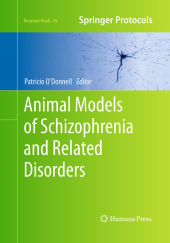 Neuerscheinungen 2016Stand: 2020-02-01 |
Schnellsuche
ISBN/Stichwort/Autor
|
Herderstraße 10
10625 Berlin
Tel.: 030 315 714 16
Fax 030 315 714 14
info@buchspektrum.de |

Animal Models of Schizophrenia and Related Disorders
Herausgegeben von O´Donnell, Patricio
Softcover reprint of the original 1st ed. 2011. 2016. xii, 290 S. 51 SW-Abb., 9 Tabellen. 254 mm
Verlag/Jahr: SPRINGER, BERLIN; HUMANA PRESS 2016
ISBN: 1-493-95788-0 (1493957880)
Neue ISBN: 978-1-493-95788-0 (9781493957880)
Preis und Lieferzeit: Bitte klicken
Animal models of schizophrenia and other major psychiatric disorders have been sought for decades and we now face new vistas on pathophysiology. Covering the key areas of research, this book explores the use of animal models in this difficult area of study.
Animal models of schizophrenia and other major psychiatric disorders have been sought for decades, and, as a result, we are now facing new vistas on pathophysiology that could lead to novel therapeutic approaches and even hint at possible preventive strategies. Animal Models of Schizophrenia and Related Disorders presents an overview of the information that can be obtained with several different models and a detailed account of how to generate such models in order to ensure that the manipulations used to model schizophrenia-relevant phenomena are used consistently across laboratories. This detailed volume features pharmacological models such as non-competing NMDA antagonists, emphasizing their use in vitro, neurodevelopmental models such as the neonatal ventral hippocampal lesion and the antimitotic MAM, models that reproduce environmental factors such as neonatal hypoxia, vitamin D deficits, and prenatal immune activation, as well as several different genetic model approaches. As a volume in the Neuromethods series, this volume contains the kind of detailed description and implementation advice that is crucial for getting optimal results.
Practical and cutting-edge, Animal Models of Schizophrenia and Related Disorders highlights the successes in the use of animal models to gain insight on pathophysiological mechanisms of relevance to major psychiatric disorders in the hope of inspiring investigators to expand the research and test targets that could restore or ameliorate function.
1. A Method to the Madness: Producing the Neonatal Ventral Hippocampal Lesion Rat Model of Schizophrenia
R. Andrew Chambers and Barbara K. Lipska
2. Gestational MAM (Methylazoxymethanol Acetate) Administration: A Promising Animal Model for Psychosis Onset
Gwena‰lle Le Pen, Alfredo Bellon, Marie-Odile Krebs, and Thérèse M. Jay
3. Prenatal Infection and Immune Models of Schizophrenia
Alan S. Brown
4. The Hypoxic Rat Model for Obstetric Complications in Schizophrenia
Andrea Schmitt, Peter Gebicke-Haerter, Ulrich Sommer, Markus Heck, Anja Lex, Mario Herrera-Marschitz, Mathias Zink, Markus Fendt, and Peter Falkai
5. The Developmental Vitamin D (DVD) Model of Schizophrenia
Darryl W. Eyles, Thomas H. J. Burne, Suzy Alexander, Xiaoying Cui, and John J. McGrath
6. Studying Schizophrenia in a Dish: Use of Primary Neuronal Cultures to Study the Long Term Effects of NMDA Receptor Antagonists on Parvalbumin-Positive Fast-Spiking Interneurons
M. Margarita Behrens
7. Glutathione Deficit and Redox Dysregulation in Animal Models of Schizophrenia
Pascal Steullet, Jan-Harry Cabungcal, Anita Kulak, Michel Cuenod, Fran‡oise Schenk, and Kim Q. Do
8. Psychiatric Genetics and the Generation of Mutant Animal Models
P. Alexander Arguello and Joseph A. Gogos
9. DISC1 Mouse Models
Yavuz Ayhan, Hanna Jaaro-Peled, Akira Sawa, and Mikhail V. Pletnikov
10. Genetically-Engineered Mice for Schizophrenia Research
Juan E. Belforte and Kazu Nakazawa
11. Epigenetic Animal Models of GABAergic Deficit in Mental Disorders
Patricia Tueting, Erminio Costa, and Alessandro Guidotti
12. Modeling Schizophrenia in Neuregulin 1 and ErbB4 Mutant Mice
Yisheng Lu, Dongmin Yin, Wen-Cheng Xiong, and Lin Mei


